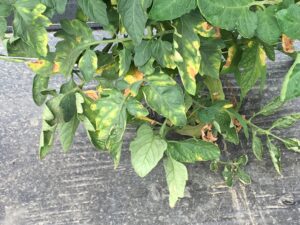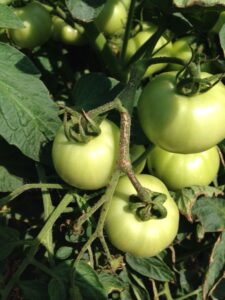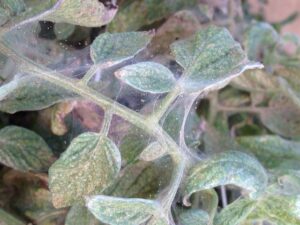Sweet Corn
European corn borer (ECB) moths continue to be captured in blacklight traps in the northern and central counties, although catches are occurring at fewer sites. The highest feeding levels are in Somerset and southern Hunterdon Counties. ECB injury is declining as infested plantings pass into the tassel stage and receive the first insecticide application. Plantings now in whorl stage are showing little feeding. While ECB has become something of a local phenomenon in NJ, growers should not assume that feeding is below economic levels in their area. ECB infestations will be present for another 1-2 weeks.
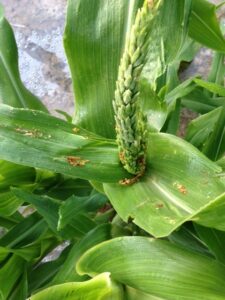 Look for the characteristic “shot-hole” type of feeding (photo below at right) and consider treating when infested plants exceed 12% in a 50 plant sample. As plantings proceed to the pre-tassel stage, ECB larvae may be found in emerging tassels (see photo at left). It is a good idea to treat individual plantings as they move into the full tassel/first silk stage one time. This eliminates any ECB larvae that have emerged with the tassels as they begin to move down the stalk to re-enter near developing ears.
Look for the characteristic “shot-hole” type of feeding (photo below at right) and consider treating when infested plants exceed 12% in a 50 plant sample. As plantings proceed to the pre-tassel stage, ECB larvae may be found in emerging tassels (see photo at left). It is a good idea to treat individual plantings as they move into the full tassel/first silk stage one time. This eliminates any ECB larvae that have emerged with the tassels as they begin to move down the stalk to re-enter near developing ears.
Useful insecticides for this particular application include synthetic 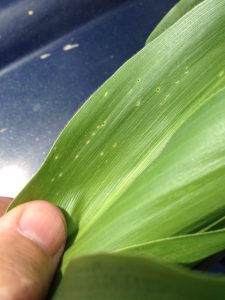 pyrethroids (IRAC Grp 3), spinosyns (including OMRI approved Entrust) IRAC Grp 5), and diamides such as Coragen or Vantacor (IRAC Grp 28) or materials such as Besiege which include the active ingredient in Coragen. Synthetic pyrethroids alone should NOT be used for corn earworm (CEW) protection on silking corn. Control with these materials is very inconsistent.
pyrethroids (IRAC Grp 3), spinosyns (including OMRI approved Entrust) IRAC Grp 5), and diamides such as Coragen or Vantacor (IRAC Grp 28) or materials such as Besiege which include the active ingredient in Coragen. Synthetic pyrethroids alone should NOT be used for corn earworm (CEW) protection on silking corn. Control with these materials is very inconsistent.
The highest nightly trap catches of ECB for the week ending 6/19/24 are as follows:
| South Branch 3 | Farmingdale 1 | Pennington 1 |
| Califon 1 | Hillsborough 1 | Princeton 1 |
| Clinton 1 | Old Bridge 1 |
Corn earworm (CEW) moths captures from northern and central blacklight traps have declined significantly, despite recent warmer night temperatures. No blacklight captures occurred toward the end of this sample period. Pheromone trap information is available from all northern and central sites, but remains limited from southern New Jersey. At present, pheromone trap captures from lower Burlington County remained high for mid-June, while northern and central county pheromone traps continue to register a persistent low population of moths. Higher catches occur where traps are placed adjacent to silking sweet corn. We will use a combination of pheromone and blacklight trap types to derive silk spray schedules by region. Silking corn is at risk of CEW infestation at this time. Be sure to access information from this publication in the upcoming weeks to determine how frequently you should treat silking sweet corn to protect it from CEW infestation.
The highest nightly pheromone trap catches of CEW for the week ending 6/19/24 are as follows:
| Tabernacle 53 | Beckett 10 | Berlin 5 |
| Allamuchy 21 | Califon 7 | Georgetown 5 |
| Woodstown 20 | Hackettstown 7 | Bellemeade 4 |
| New Egypt 12 | Hammonton 7 | Pennington 4 |
Using our current pheromone- based thresholds (30″ Hartstack trap) developed by the Univ. of Delaware, nightly corn earworm moth catches translate to:
0 moths – 6-7 day spray schedule
1 moth – 5 day spray schedule
2-20 moths – 4 day spray schedule
>20 moths – 3 day spray schedule
Silking Spray Schedules*:
South – 4 days
Central – 4-5 days
North – 4-5 days
*These recommendations are based on regional catches. Adhere to tighter spray schedules if indicated by local trap catches. Synthetic pyrethroids alone should NOT be used for corn earworm (CEW) protection on silking corn, or for fall armyworm (FAW) management at any stage. Control with these materials is very inconsistent.
Tomatoes
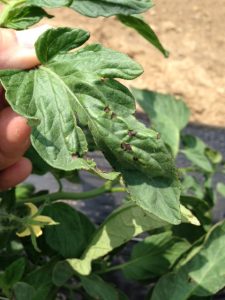 Bacterial leaf spot (BLS) symptoms have been absent from scouted fields from Burlington county northward. As tying and pruning events happen, growers should be on the lookout for BLS and bacterial canker. Symptoms of BLS infection include small, very dark lesions appearing on foliage of any age (see photo at left). Often even immature, unexpanded leaves are affected. Copper resistance in BLS populations in NJ has been identified. Bacterial canker is first characterized by marginal lesions on older foliage (photo below at left). These lesions work inward, ultimately killing entire leaves. Fruit lesions, also called bird’s eye spot (photo below at center) are initiated on very small fruit but become apparent as fruit enlarge. Dry lesions also may form on petioles (photo below at right). It is advisable that growers avoid working in fields when foliage is wet, to avoid easy spread of infections. Growers should also work from youngest blocks to oldest, to limit the chance of spreading disease to younger plants. Pruning, tying and harvesting are all ways that these diseases are dispersed throughout plantings. Bacterial infections in the field may be mitigated to some degree with systemic immune response activator Actigard, although results are often limited if weather and human activity favor spread. See the Tomato Section of the 2024/25 Commercial Vegetable Production Recommendations for further information.
Bacterial leaf spot (BLS) symptoms have been absent from scouted fields from Burlington county northward. As tying and pruning events happen, growers should be on the lookout for BLS and bacterial canker. Symptoms of BLS infection include small, very dark lesions appearing on foliage of any age (see photo at left). Often even immature, unexpanded leaves are affected. Copper resistance in BLS populations in NJ has been identified. Bacterial canker is first characterized by marginal lesions on older foliage (photo below at left). These lesions work inward, ultimately killing entire leaves. Fruit lesions, also called bird’s eye spot (photo below at center) are initiated on very small fruit but become apparent as fruit enlarge. Dry lesions also may form on petioles (photo below at right). It is advisable that growers avoid working in fields when foliage is wet, to avoid easy spread of infections. Growers should also work from youngest blocks to oldest, to limit the chance of spreading disease to younger plants. Pruning, tying and harvesting are all ways that these diseases are dispersed throughout plantings. Bacterial infections in the field may be mitigated to some degree with systemic immune response activator Actigard, although results are often limited if weather and human activity favor spread. See the Tomato Section of the 2024/25 Commercial Vegetable Production Recommendations for further information.
Two-spotted spider mites (TSSM) are being found in a few tomato high tunnels at this time. This is fairly common in the dry conditions inside the tunnels. Initial, low-level infestations result in a mite “stipple” on the upper leaf surface (see photo at right). In these cases several mites may be found on the lower leaf surface. With hot, dry conditions and no control applied, mites multiply rapidly. A large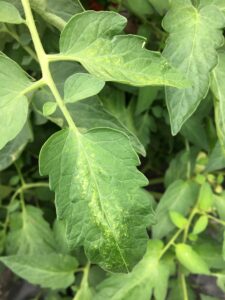 population will create webbing that can cover entire plant leaves and branches (see photo below). Large populations can become quite difficult to manage, so treatment should be applied upon finding a mite infestation at any level. This can limit future problems with this pest. There are a number of effective miticides listed in the Tomato Section from the 2024-25 Guide.
population will create webbing that can cover entire plant leaves and branches (see photo below). Large populations can become quite difficult to manage, so treatment should be applied upon finding a mite infestation at any level. This can limit future problems with this pest. There are a number of effective miticides listed in the Tomato Section from the 2024-25 Guide.
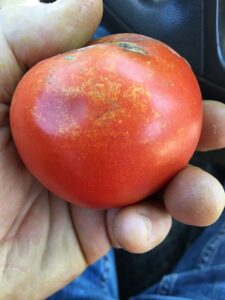 Thrips infestations are also appearing now in some high tunnels. Warming weather will also result in field infestations in many areas. These
Thrips infestations are also appearing now in some high tunnels. Warming weather will also result in field infestations in many areas. These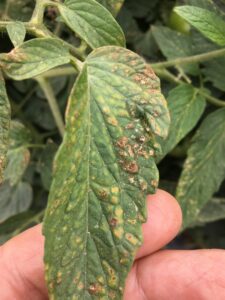 insects initially feed on foliage (see photo at right), and ultimately move to the surface of fruit, where they cause gold flecking to occur on ripening fruit (photo at left). While all “gold fleck” is not related to thrips, that which forms distinct rings and trails on fruit surfaces is caused by their feeding. Thrips can be difficult to manage due to insecticide resistance issues and their habit of hiding in blossoms and other tight spaces on the plants. It is best to apply control before populations become widespread in plantings. See the Tomato Section from the 2024-25 Guide for suggested insecticides.
insects initially feed on foliage (see photo at right), and ultimately move to the surface of fruit, where they cause gold flecking to occur on ripening fruit (photo at left). While all “gold fleck” is not related to thrips, that which forms distinct rings and trails on fruit surfaces is caused by their feeding. Thrips can be difficult to manage due to insecticide resistance issues and their habit of hiding in blossoms and other tight spaces on the plants. It is best to apply control before populations become widespread in plantings. See the Tomato Section from the 2024-25 Guide for suggested insecticides.
Beet Armyworm
Pheromone catches of beet armyworm (BAW) in the Woodstown area are in the 4-5 moths per night range. This pest can cause significant injury on peppers as well as leafy greens like swiss chard. Monitor pepper fields weekly for signs of feeding. BAW larvae (photo at left) feed in the developing foliage in terminal growth of plants. Initially, leaves are skeletonized, but as larvae grow, they will move onto fruit and damage these as well. Extreme injury to swiss chard and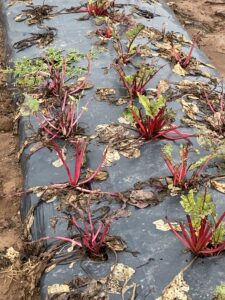
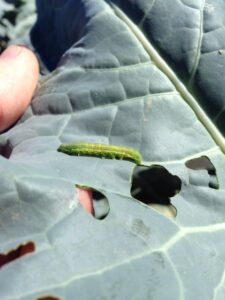 collards can occur very quickly (photo at right). In northern NJ, BAW is an occasional, and typically low level pest of cole crops. Infestations tend to be very local for unknown reasons. As with other armyworms, BAW is difficult to control with pyrethroid insecticides. Effective materials include spinosyns (IRAC 5) and diamides (IRAC 28).
collards can occur very quickly (photo at right). In northern NJ, BAW is an occasional, and typically low level pest of cole crops. Infestations tend to be very local for unknown reasons. As with other armyworms, BAW is difficult to control with pyrethroid insecticides. Effective materials include spinosyns (IRAC 5) and diamides (IRAC 28).
Pepper Weevil – Correction – new email address
Dr. Joseph Ingerson-Mahar (Ret.) has a number of sticky cards and dowels for pepper weevil traps, and is willing to help growers obtain these components as well as lures from a supplier. Contact him for assistance in this, and with deployment of traps and identification of weevils. Dr. Ingerson-Mahar’s email is: patrobus@comcast.net
Cucurbit Downy Mildew
A sentinel plot is now established at Snyder Farm in Hunterdon County. This plot, consisting of pumpkin, watermelon, cantaloupe, butternut, acorn, cucumber and kabocha squash will be used to indicate the presence of cucurbit downy mildew in the region, and what crops are affected. For regional information on this important disease, see the Cucurbit Downy Mildew webpage: http://cdm.ipmpipe.org/. Note that the forecast component of this site is not active. However, reports of CDM can still be found on the site, and will appear on the homepage map down to county level, with associated host information.
